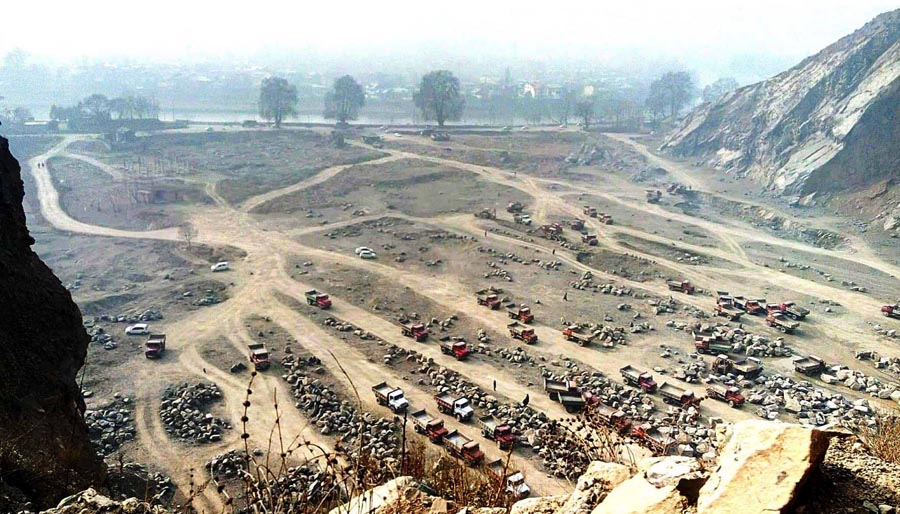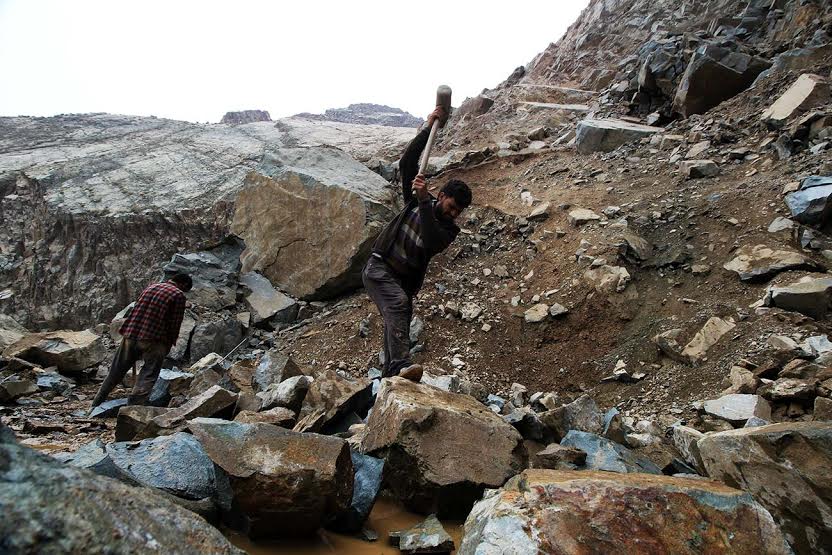
The quarry-holders of Athwajan claim to have been the main suppliers of construction raw materials in Kashmir valley before the ban order.
THE miners from Athwajan belt who were permanently disenfranchised by a 2016 order accuse the then and successive governments of “revenge politics” and “malignant rules”.
Stating that the belt was used by Kashmiris for extracting stones since their great grandparents ventured into this business, the quarry-holders proudly claim to have been the main suppliers of construction raw materials in Kashmir valley before the ban order.
“It was a bajri hub and the centre for Kashmir’s highest quality,” a quarry-holder said.
For the people from this region, there exists no scope to restart operations even after a lengthy wait for clearances and other permits. Unlike the mines from other areas in Kashmir which have been delegitimized over the lack of newly prescribed clearances, the Athwajan tragedy is that it is a direct ban.
Why?
The ‘bad face’ or poor look presented to the travellers on the Srinagar-Jammu highway due to the presence of the mining belt on that route has been listed as the first and foremost reason for the ban. Any resultant ecological damage has been marked as the secondary reason.
This order came eight months after the declaration of new rules under SRO 105.
“Please see the state of the highway from Qazigund till Athwajan,” Nazeer Bhat, a quarry-holder, said.
“It’s filled with quarries and gives a horrid look. It was beautiful there. Athwajan and Pathan Chowk have no jungles around them and that’s the exact reason why it is naturally well-placed for stone extractions. Ancestral wisdom had narrowed down mining activities to that belt for a reason.”
There are other mines placed on the Srinagar-Jammu highway, said Mushtaq Bhat, a quarry-holder from Athwajan. “It’s really uncanny that the same logic does not apply to them.” The only bad face it presents, he said, was to the elitist trustees of Delhi Public School (DPS), Srinagar.
Pointing out to the fact that their quarries were visible from DPS’s rear side, the miners accused the former PDP-BJP government of playing dirty politics with them. “After a fallout with former PDP MLA from Sonawar, Mohammed Ashraf Mir, the dispensation ordered the ban,” Mushtaq maintained.
‘We were promised rehabilitation’
Forbidden to execute their professional duties, innocent and struggling, the Athwajan miners had staged protests, demonstrations, and organised meetings with concerned officials for resuming work.

They were first promised rehabilitation in the form of new sites where they can continue their ancestral businesses. This part of the Athwajan chapter was being overlooked by former Divisional Commissioner Baseer Ahmad Khan.
ALSO READ: Kashmir’s Banned Stones — Part I: Closure of Century Old Quarry
The fact that the ‘new sites’ were located merely 500-600 metres away from the banned spots, in Zewan, had bewildered the miners then. They said that the authorities contradicted themselves by promising them rehabilitation in an area so close. “What happened to their ‘bad face’ logic, we do not know,” they said.
There was another conundrum.
A Border Security Force (BSF) office was already built and operational on a territorial level higher than that of the proposed sites.
“We accepted it,” Nazeer, the quarry-holder, continued, “but did they not know that we would’ve needed to ‘develop’ those new points from scratch? That we would not have been able to extract or earn until the sites had been fully developed for use? Would they’ve also compensated us for this obvious fact apart from merely promising us a physical transfer of business? Also, the location is so close… How does it justify shutting the quarries at Athwajan?”
In any way, the locals said that their consent to being rehabilitated in Zewan meant nothing.
Because alarmed about the development, the BSF office had written to Baseer Khan, categorically stating that such a thing could not materialize near their quarters. Even the Wildlife Conservation and Forest Department, whose fence cut through the new site, had said that their area could not be compromised for the miners.
The Department of Geology and Mining wrote to the government informing them that it is ready to move the Athwajan excavators but other departments and institutions were hindering the process. Since then, the matter has stayed at that. The rehabilitation plan has not matured at all.
Much later, under the leadership of ex-governor Satya Pal Malik that also took away J&K’s special status, were the miners provided some hope.
Noting the genuinity of their problems, a committee was formed to investigate the possibility of scientific, systematic mining in the region. The committee had concluded through its surveys and examinations of five months that small-scale scientific mining for minor minerals through clusters can continue in the region.
“We promised to obey all norms and sent an application to the government,” Mushtaq, the quarry-holder, continued. “They said that there was scope in an area named ‘Alfata D’ and in northwest Pantha Chowk on July 10, 2019. Then the abrogation happened and no work to materialise the committee’s findings has been done. We remain in the same state after the 2016 ban, if not worse and that is bad enough.”
The administration has been accused, by Athwajan locals, of non-fulfillment of their promises and ignoring its own committee’s recommendations that will save their livelihoods. The incumbent Divisional Commissioner of Kashmir acknowledged both, “Yes, all the plans and proposals are ready. But nothing has happened.”

Nazeer described his troubles as ‘khatarnak’ – an Urdu word for something that is a deadly combination of dangerous and scary. “Because locals here have been involved in this business traditionally, even well and highly qualified youngsters come back to run their quarries after completing their education,” he said.
But for the past four years, all these souls are sitting unemployed, he asserted. “It has caused a mental health epidemic. We don’t just need rehabilitation but also monetary compensation for all these years that we survived with our livelihoods snatched.”
Around 5 lakh people have been associated with this industry, Nazeer informed, and all of them are in financial distress since the past few years. “There are many PhD holders in Athwajan who are sitting idle and mentally frustrated. We have never seen such bad days.”
ALSO READ: Kashmir’s Banned Stones—Part II: Penalties, Nexuses And Costly Homes
The Deputy Director of the Department of Geology and Mining, Dr Amarjeet Singh Sodhi, refrained from commenting on the issues of the Athwajan belt, when approached by Kashmir Observer as he “did not know much about what Baseer Ahmad Khan did” during his tenure.
However, Nadeem Qadri, an environment lawyer, identified three factors that may have contributed to the Athwajan order: the Srinagar Master Plan, the New Minor Mineral Rules incorporated into the J&K’s territorial jurisdiction and the Environmental Protection Act.
“Every mine has a carrying capacity and every mine in Athwajan has exploited its carrying capacity due to the age-old mining operations there,” Qadri said.
“The Smart City Plan compels the bureaucrats to question the presence of an ecological sensitive area in the limits of the ‘smart city’. Dust and pollution are also problems. They are conceiving an idea for a bio-diversity park there,” he disclosed.
But Zeeshan Rehman, the acting chairperson of the Senior Contractors Coordination Committee (J&K), while arguing that there’re scores of big factories in the specified ‘eco-sensitive zone’, contended that ‘one cannot hide behind the smokescreen of NGT and environment rules and destabilise lives’.
“The stone miners reiterated that they’re willing to work with the government to conserve the ecology of Kashmir, only if the government worked itself,” contractor Zahoor Dhar exclaimed. “We’re prepared to do whatever they need us to but they’re not willing to listen or work towards our issues!”
But, a strong advocate of sustainable development, Nadeem Qadri recommended “something like an Environmental Protection Agency” in J&K.
“It must act like a centralised one-stop-shop for all clearances and permits from environmental authorities. Right now, people are seeking 10 different permissions, all from different offices. A centre like that ought to streamline the process more,” he suggested.
But on being asked if the objections raised by the locals were legitimate in his view as an environmental lawyer, Qadri stated that the stone excavators had full moral standing on their allegation. “It is true. The legal community also objected to SRO 105 when it came out, but now with Article 370 gone, it has become harder,” he said, mentioning that the extraction of sand in river Jhelum, Sindh, Lidder, etc, are more serious issues to him.
“The government is merely a custodian of natural resources. The first right is of the people. If someone wants to extract, then they should be able to with government permission. If someone comes from, for example, Punjab and extracts 10 feet sand instead of 2, then that is exploitation and its impact will be very adverse. Whatever happens in J&K must happen while maintaining ecological balance and providing the natives their first right to use and sell natural resources judiciously,” he asserted.
Plans to auction stone mines in a few years

Conversations with different officers from the Department of Geology and Mining helped us uncover a plan not yet announced in the larger public domain.
Stone mines, unlike the long gone sand blocs, might be put up for auction in the next 5 years.
“The rules will allow the ones who’ve ancestrally occupied stone quarries the first right over running them for the first five years of their new license – which they will only receive after all the documents listed in SRO 105 are ready and processed,” Khurshid Mir, Assistant Mineral Officer, told Kashmir Observer.
An officer from the Department, who wished to remain unnamed, confirmed that the government plans to auction Kashmir’s stone quarries, after the locals’ licenses expire.
“The license to mine is valid for a minimum of three years since its issuance and can be extended upto five years,” he said.
Naya Kashmir, development, and demagoguery
Prime Minister Narendra Modi had promised to change the face of Kashmir within four months of the abrogation. His party members and he had delivered grandiose speeches promising a world of development, savvy infrastructure, and most importantly ‘peace’, on the floor of the Parliament. Pitiably, on ground and mixed in conspiratorial dust is Kashmir’s dried out economy and frozen society.
The much-celebrated and justified argument of ‘development’ has not seen any real manifestation, especially after the abrogation of Article 370. Moreover, the primary industry providing the foundational material for ‘development’ has been shut and locked until the next (rude) awakening.
“This industry is the backbone of Kashmir’s infrastructure. Without us, construction cannot happen. How are they able to make these false promises and close us down simultaneously, we do not understand,” most of the stone excavators complained.
Even today, they ask for short term permits so that they can arrange for everything the government has asked for.
“It’s known to all that these official processes take their own time. If we’re given permits in the meantime, the tendered projects will be completed, the Department will earn a little more, and we will finally be able to work! It is a win-win. If only they cared,” Nazeer Bhat stated desolately.
Concluded.
Follow this link to join our WhatsApp group: Join Now
Be Part of Quality Journalism |
Quality journalism takes a lot of time, money and hard work to produce and despite all the hardships we still do it. Our reporters and editors are working overtime in Kashmir and beyond to cover what you care about, break big stories, and expose injustices that can change lives. Today more people are reading Kashmir Observer than ever, but only a handful are paying while advertising revenues are falling fast. |
| ACT NOW |
| MONTHLY | Rs 100 | |
| YEARLY | Rs 1000 | |
| LIFETIME | Rs 10000 | |










